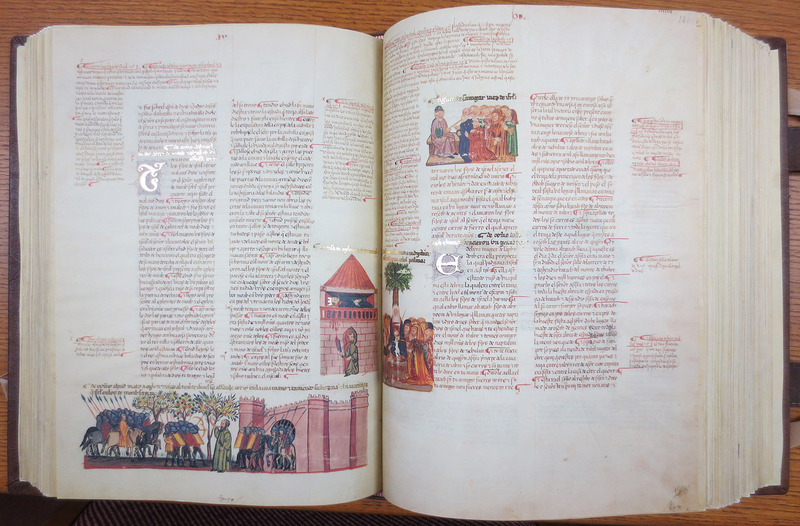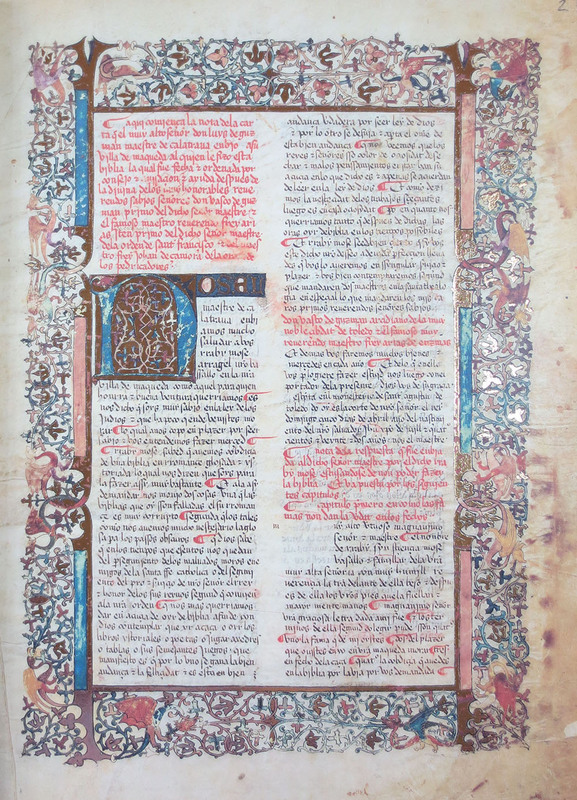The Alba Bible
La Biblia de Alba.
Madrid: Fundación Amigos de Sefarad, 1992.
Call Number: (RARE) BS 988 1992
Special Collections, Golda Meir Library
The Alba Bible was created near the end of the manuscript era, in fifteenth century Spain. Following a five-hundred year bloom of Sephardic Jewish culture and scholarship in Spain, there had been a series of anti-Semitic riots in Madrid. The Catholic Grand Master of Calatrava, Don Luis de Guzman of Maqueda, commissioned a Hebrew interpretation of the Bible, in hopes that a beautifully illuminated manuscript Bible, translated into vernacular Castillian Spanish from the Hebrew, with rabbinical commentary, would promote tolerance and understanding between the religions.
The first 25 folios of the Bible transcribe correspondence between Guzman and Rabbi Arragel of Guadalajara, who was chosen to undertake the project in 1422. Arragel had grave doubts about the project, fearing that the inevitable conflicts with Christian doctrine might expose Spanish Jewry to further attack, and mindful of the Jewish prohibition against illuminated manuscripts. The goals of the project were steadily eroded: Guzman appointed two monks to supervise Arragel, who completed the project June 2, 1430 in Maqueda. When the text was seized for scrutiny by Franciscan censors at Toledo and the University of Salamanca, Rabbi Arragel disappeared from the pages of history. Following a period of public disputation, the manuscript was abandoned, possibly disbound. Hope of Judeo-Christian reconciliation was abandoned in 1492, when the King signed an expulsion order.
The surviving text remains as an icon of tolerance. Jewish culture traditionally prized books for content and physical beauty, and had been instrumental in bringing Semitic texts to Europe. Rabbi Arragel took pains to make the Alba Bible a legacy of the Golden era of Sephardic scholarship, boldly avoiding concessions to Christian thinking. He included in his commentary extracts from rabbinical writings and the Quabbalic Zohar, and illustrations specifically depicting Jewish scriptural interpretations and religious objects. Despite Arragel's perseverance in controlling the text, there are marked Christian influences on the Alba Bible, including an entire passage lifted from the Christian Latin vulgate. The Alba Bible is an iconographic bridge between two magnificent traditions: Spanish Catholic manuscript illumination and European Sephardic scholarship.
The superb manuscript, 513 folios with 334 miniatures, did not resurface until 1622 in the Library of the Liria Palace, seat of the Grand Duke of Alba and Berwick. In 1992, the quinquentennial of the Jewish expulsion, the Duke of Alba authorized this facsimile edition of five-hundred copies. A copy was presented to King Juan Carlos of Spain on March 31, 1992, in recognition of the historical contributions of the Sefarad community to Spanish culture, and proceeds of the editions were dedicated to the promotion of Jewish culture in Spain. The UWM copy is one of 150 Founders Copies in a special presentation case.


